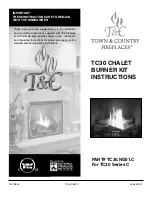
4
Section 2.0 - PRE-INSTALLATION REQUIREMENTS
2.1. MASONRY & ZERO CLEARANCE REQUIREMENTS
The masonry fireplace must meet the minimum code requirements, or NFPA 211 or the
equivalent for a safe installation. Contact your local Building Inspector for requirements in your
area. An inspection of the fireplace should include the following:
1. CONDITION OF THE FIREPLACE AND CHIMNEY: Examine the masonry fireplace and
chimney prior to installation to determine that they are free from cracks, loose mortar,
creosote deposits, blockage, or other signs of deterioration. If evidence of deterioration is
noted, the fireplace or chimney should be upgraded prior to installation.
2. INSTALLATION
INTO
AN
EXISTING FACTORY-BUILT
ZERO-CLEARANCE
FIREPLACE: It is possible to install a wood insert into an existing factory-built zero-
clearance fireplace. However, there currently exists no UL or ULC standard specific to that
type of installation. The first thing that must be verified is that the factory-built zero
clearance fireplace is listed (it must be certified by a competent certification body such as
Omni or Warnock Hersey). It must be suitable for use with solid fuel and nothing in the
owner’s manual must specifically prohibit the installation of a fireplace insert. When in
doubt, check with the fireplace manufacturer. The installation of the zero-clearance
fireplace MUST be thoroughly inspected by a professional in order to ensure that it still
meets the manufacturer’s specs and code conformity. The chimney must be of at least 1"
(25 mm) larger in diameter to accommodate a required continuous stainless steel liner
running from the flue collar to the top of the chimney termination.
Never remove parts that serve to insulate the zero-clearance fireplace from combustible
material. Only readily detachable parts that are easily replaced, such as damper parts,
screens, and doors, are to be removed from the fireplace. These parts must be stored
nearby and available for retrofit if the insert is ever removed. Removal of any parts which
render the fireplace unfit for use with solid fuel requires the fireplace to be permanently
labelled by the installer as being no longer suitable for solid fuel until the removed parts are
replaced and the fireplace is restored to its original certified condition. Furthermore, any air
vents, grilles, or louvers that serve to create an air circulation pattern around and outside
the zero-clearance fireplace shall never be removed.
3. CHIMNEY CAPS: Mesh type chimney caps must have provision for regular cleaning, or the
mesh should be removed to eliminate the potential of plugging.
4. LINER: The chimney must have an acceptable masonry liner suitable for solid fuel,
otherwise a continuous stainless steel liner must be installed.
5. ADJACENT COMBUSTIBLES: The fireplace should be inspected to make sure that
there is adequate clearance to combustibles, both exposed combustibles to the top,
side, and front as well as concealed combustibles, in the chimney and mantel area.
Your local inspector should have information on whether older fireplaces are of
adequate construction.
















































